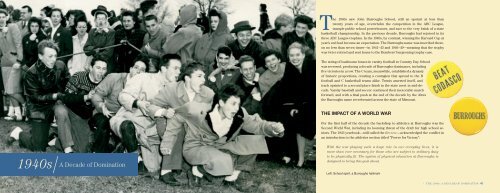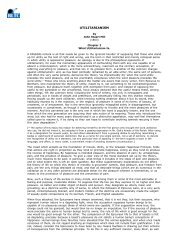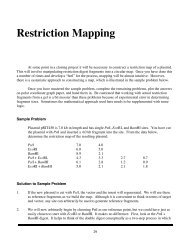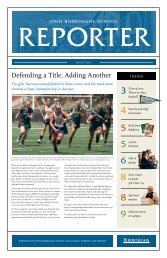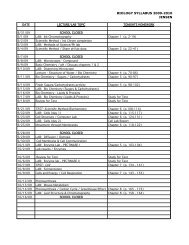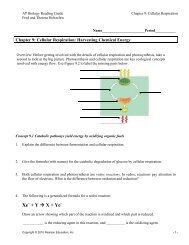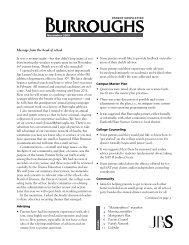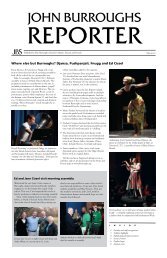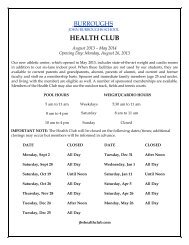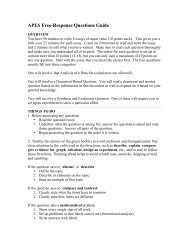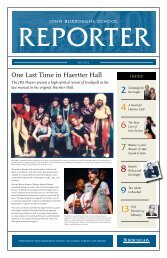1940s A Decade of Domination - John Burroughs School
1940s A Decade of Domination - John Burroughs School
1940s A Decade of Domination - John Burroughs School
Create successful ePaper yourself
Turn your PDF publications into a flip-book with our unique Google optimized e-Paper software.
Country Day struck in the third quarter after a sustained drive, “but this was quickly remedied as Jimmy Jenkins ranthe CDS kick<strong>of</strong>f back for 85 yards and proved himself without a doubt the fastest man on the field.” When the Bombersregained possession, they “rolled unmolested from mid-field into striped territory for the final tally <strong>of</strong> the game,” scoredby Lawrence Manchester ’43. Jenkins gained a whopping 185 yards; the bulwarks on the line were Beisman at right endand right tackle Fred Eiseman ’43, son <strong>of</strong> two <strong>of</strong> <strong>Burroughs</strong> founders and later a revered science teacher and footballand baseball coach at JBS from 1950 to 1961. Beisman-Eiseman allowed only twenty-five yards around their end on a daywhen Country Day gained a total <strong>of</strong> 254 on the ground. Evatt Sante ’43, an outsized lineman for his time at 220 pounds,kicked four extra points, which the World called a story in itself. “Very seldom in high school football is a place kick attemptedfor the extra point; but those boys had it down to a science.”Still smarting from the surprise bat play <strong>of</strong> 1941, the World seized on the victory to chasten Country Day: “For the firsttime in 11 years, we have a real victory to talk about. . . . Last year made a deep impression on the team <strong>of</strong> <strong>John</strong> <strong>Burroughs</strong>.This year, Codasco was ‘batted’ into ignominious defeat for their meager victory.”The 1942 season would have been perfect but for a 7–6 loss to Ritenour. Another season highlight was the first win in fiveyears over Western Military Academy, 9–7, despite the absence <strong>of</strong> three <strong>Burroughs</strong> starting backs and a regular end. TheBeisman-Eiseman duo excelled again, sacking a Western runner for a safety. Bill Kieffer ’45, the starting center, scored ona seventy-yard jaunt with an intercepted pass, aided by key down-field blocks from Beisman and Kip Corneli ’43.Fisticuffs at the Big GamePerhaps it was inevitable. Despite the World’s admonitionthat the rivalry with Country Day not turn intoa feud, emotions <strong>of</strong> the moment ultimately seizedcontrol at the game <strong>of</strong> 1942, with partisans on bothsides finally crossing the line. A sub-headline in theWorld on <strong>Burroughs</strong>’ shellacking <strong>of</strong> the Rams exclaimed,“Goal Posts Torn Down in Fierce Fight FollowingGame.” Perhaps out <strong>of</strong> decorum, the storyprovided no further details.<strong>John</strong> Minton ’46 was a freshman at the time atWydown Junior High <strong>School</strong> who entered <strong>Burroughs</strong>in the tenth grade and started on the school’s firstundefeated team in 1945. Minton supplied details onthe melee in written recollections prepared for thisbook:Multiple <strong>Burroughs</strong> players received post-season honors: Namedto the All-ABC League first team were Beisman, Sante, and Jenkins;placed on the second team were Eiseman, halfback Manchester,quarterback Deas, left-end Scott Pollock ’44, and leftguard Corneli. Beisman also made the All-District second team.Jimmy Jenkins sweeps left in the 1942 victory over CDS.In November 1942, JBS trounced CDS 28–7 atCountry Day. I attended that game, and whenit was over the JBS fans rushed on the field totear down the goal posts, and the CDS fanscame out in force to defend them. In the middle<strong>of</strong> this swirling mass <strong>of</strong> pushing and shovingwas a tall blond woman, dressed in highheels, stockings and a full-length mink coat,using her purse for a bolo against the CDS defenders.That woman was Mrs. Jule Miller themother <strong>of</strong> Jule Miller ’43, who played in thatgame, and Marilyn Miller ’45.46 JOHN BURROUGHS / THE <strong>1940s</strong>: A DECADE OF DOMINATION 47
BASKETBALL EMERGESVarsity basketball captured its first league championship in school history in 1940–41, compiling an 11–1 record in regular-seasonplay and adding two victories in the post-season district tournament. The starting five were Julian Beisman, Edward “Bud” Samuels,Charles Renard, and Robert Zelle, all ’41, and Ted Martin ’42. The backups were Robert Matthews and Charles Ellaby, both ’42.The Bombers were known for their second-half heroics, as in the second Principia game which they won 38–30 to secure thechampionship. The game was tied after three quarters, but “the Bombers put on one <strong>of</strong> the most beautiful displays <strong>of</strong> basketballever seen at <strong>Burroughs</strong> to go ahead and win in the final quarter,” reported the Review. <strong>Burroughs</strong> reached the quarterfinals <strong>of</strong>the district tournament by beating Pacific behind “Big Moose” Renard’s ten points, and then beating Brentwood, led by Bob Zellewith fourteen points.1940–41 basketball team, first league champs. Back rowfrom left: Coach Staten, R. Zelle, C. Renard, E. Samuels, F.Eiseman (manager); front row: C. Ellaby, T. Martin, J. Beisman,R. Matthews.Varsity basketball added a second league crown in 1942–43 with a modest record <strong>of</strong> 4–2 in league play—but with a 36–14 thrashing<strong>of</strong> Country Day in the first encounter. Bill Kieffer, merely a sophomore, and Loy Ledbetter ’43 were strong on the inside while BobSalisbury ’43 was the high scorer. The team plummeted in the next two years, but Kieffer led the league in scoring and earnedAll-League honors in both campaigns; Jerry Rubenstein ’45, captain in 1944–45, also earned All-Conference recognition.Basketball returned to prominence in 1946–47 under first-year coach Ray Wolfe, sharing the league title with Western andcompiling a regular-season record <strong>of</strong> 8–3. One or more <strong>of</strong> <strong>John</strong> Pfeifler ’47, Bob Maune ’47, and sophomore Dave Sisler ’49 usuallyscored in double figures. The two seniors made first-team All-ABC, and Sisler, a portent <strong>of</strong> things to come, was on the secondteam.In district play, Cleveland High <strong>School</strong> routed <strong>Burroughs</strong> in a David-versus-Goliath matchup. <strong>Burroughs</strong> as David wouldslay many a Goliath as it marched through the state tournament in 1949, but that is a separate story.FLUX IN THE COACHING RANKSGeorge Staten was named head football, basketball, and baseball coach in 1935, opening auspiciously with a 3–1–1 record infootball and a three-way tie for the league title. Staten proved himself something <strong>of</strong> a coaching Houdini with his ability to dividehis time. Between 1940 and 1944 he twice coached A and B basketball at the same time, and in 1941–42 he tacked on the C teamas well. Staten was replaced in 1945 by Lyle Bennett in varsity football and basketball, but he continued as the head coach inbaseball, compiling an uncommonly strong record, and at the C level in football and basketball with breathtaking results.1941–42 tip<strong>of</strong>f in the old gym.Bennett, formerly a football assistant to the renowned Fritz Crisler at Michigan, led <strong>Burroughs</strong> to its first undefeated football48 JOHN BURROUGHS / / THE <strong>1940s</strong>: A DECADE OF DOMINATION 49
season (one tie) in 1945 and a second-place finish in the state track meetin 1946. He was succeeded by Raymond Wolfe, who took <strong>Burroughs</strong> tounprecedented heights on the gridiron and the hardwood in his sevenyearcareer.A celebrity joined the coaching staff for a single year in B football—DickYore, a three-year starting quarterback for Coach Jimmy Conzelman’sfamous Washington University teams <strong>of</strong> the 1930s, which held their ownagainst Army, Notre Dame, Illinois, Missouri, and SMU. Yore, a member<strong>of</strong> his university’s Sports Hall <strong>of</strong> Fame, became a thoracic surgeon andsent two children to <strong>Burroughs</strong>, Michael ’68 and Lisa ’74. He coachedthe Bulldogs to a 5–1 record and a league championship. At the footballbanquet, an appreciative squad presented the budding physician with ablood pressure instrument.“The Saw Is Sharpened”On a Saturday morning in January 1944, Deyo “Sam” Leland, <strong>Burroughs</strong>athletic director from the inception, was sawing wood at his home inGlendale. He came inside to rest, telling his wife he thought the saw wasdull. He did not return to his chores. The man who had charted <strong>Burroughs</strong>’illustrious athletic course died at the age <strong>of</strong> fifty-one. In additionto serving <strong>Burroughs</strong>, Leland had contributed mightily to the Boy Scouts,receiving the highest honor for volunteer leadership—the Silver BeaverAward. On behalf <strong>of</strong> a grieving <strong>Burroughs</strong> family, the World wrote:The saw is sharpened: For as long as <strong>John</strong> <strong>Burroughs</strong> <strong>School</strong>lives, the life <strong>of</strong> Coach Deyo S. Leland will be a symbol <strong>of</strong>unstinting devotion to the principles <strong>of</strong> thinking, being andplaying clean.A memorial drinking fountain was initially planned near the amphitheater,but the final remembrance was something more consonant with Leland’scontributions: In 1949, the football field was christened—and has foreverremained—Leland Field.The First Man from DartmouthIn 1946 a determined young man named George Raymond Wolfebegan a stunning seven-year career at <strong>Burroughs</strong> as head coach <strong>of</strong>football, basketball, and track. So spectacular were his results thatsome forget he also taught math. He was the first man from DartmouthCollege; the second was Jim Lemen (1963–66, 1970–2011).Wolfe, square-jawed and serious, was a three-year standout runningback at Dartmouth, followed by three years in the Navy playing basefootball and serving as a pilot and navigator in the Pacific. At thetime <strong>of</strong> Wolfe’s death in 2002, Chuck Thies ’49 described him for the<strong>Burroughs</strong> Reporter:Coach Wolfe was laid-back and usually wore a half smile thatmade you wonder what he was thinking. There must have beena fair number who admired that demeanor because it seemedthat a good many, some perhaps unconsciously, emulated it—maybe still do. It is interesting to speculate how much <strong>of</strong> RayWolfe is part <strong>of</strong> the lads who performed under his mentorshipin the following years.In football, Thies wrote, Wolfe inherited a rebuilding job rivalingthe Marshall Plan. The entire first string <strong>of</strong> the great 1945 teamhad graduated. His first season was mediocre—a 4–4 record—butsomething happened the week before the Country Day game thatthe players would never forget.Dave Sisler ’49, a sophomore like Thies, told the story: “He challengedeach player, mano-a-mano. I’ve never seen anything like it in my life.They were going to hit or be hit. A player was a man or a mouse—and all the mice had Ray Wolfe to contend with. When Saturdaycame, it was a different team. We went over and beat them 19–0.That’s when my athletic career began—right there.”Peter Fischer ’53, a key member <strong>of</strong> the 1953 state basketballchampions, recalled another instance <strong>of</strong> Wolfe’s no-nonsenseapproach to his job: “During the season, Ray Wolfe called the entireteam into the chalk talk room and told us that we should take themessage home to our parents that he was the coach and he was notinterested in any more gratuitous advice from parents <strong>of</strong> the teamabout who should play for how long.”In seven seasons Wolfe won four ABC football championships, goingundefeated in two <strong>of</strong> those years and 6–1 in the other two. His teamsbeat Country Day in his first six years, finally bowing in his final season<strong>of</strong> 1952. His basketball record was even more remarkable: <strong>Burroughs</strong>won the league title in six <strong>of</strong> his seven seasons, only twice by tie, andbetween 1949 and 1953 he went on a state-championship tear:• 1949: fourth place in the state tournament;• 1951: a twenty-three-game winning streak and third placein state;• 1952: another run through the regionals into the statetournament with a season record <strong>of</strong> 29–2;• 1953: a 27–1 season and <strong>Burroughs</strong>’ first and only statebasketball championship.In track, Wolfe’s 1950 team placed second in the district and fifth inthe state meet, half a point from third. In 1951, competing againstsome eighty schools, <strong>Burroughs</strong> rose to fourth in the state, and in1952 they were crowned state champions.Wolfe left <strong>Burroughs</strong> in 1953 for private industry, first with RalstonPurina and later with other companies outside St. Louis. He neverreturned to coaching, but he maintained contact over the years withmany <strong>of</strong> his <strong>Burroughs</strong> players.50 JOHN BURROUGHS / / THE THE <strong>1940s</strong>: A DECADE OF DOMINATION 51
CHEERLEADING EVOLVESWomen’s suffrage became law in 1920 by the Nineteenth Amendment to the Constitution. Twenty-nine years later, <strong>Burroughs</strong>girls gained the right to be cheerleaders by vote <strong>of</strong> the student body.There was never a shortage <strong>of</strong> enthusiasm for the <strong>Burroughs</strong> teams, but in the early years support was ad hoc and illorganized.Student body legislation in 1939 established a cheerleading corps—but it was strictly a male domain. Throughballots distributed in advisories, the school elected a squad <strong>of</strong> three boys: James Alexander and Clement “Bub” Pollock,both ’41, and Donald Charles ’42. They were succeeded in January the following year by Ted Martin ’42, Evatt Sante ’43,and Laurens “Laurie” White ’43—all to receive <strong>Burroughs</strong> letters for their efforts at the spring athletic banquet. A monthlater, the student council, realizing that too <strong>of</strong>ten the cheerleaders themselves were involved in games, expanded thegroup to six. The World was fully behind the effort, down to explicit instructions on the art <strong>of</strong> cheering:The most effective cheer is the one that is given in perfect unison with the motions <strong>of</strong> the cheerleader. . . . Starton the FIRST syllable. Keep together and snap it out at the correct time. . . . If you pitch your voice up andforce the sound against your teeth, this will save your voice and give a clearer, sharper tone to the yell.The World closely monitored attendance at games, chastising the student body when needed. “Despite a great deal <strong>of</strong>prompting from this editorial column,” the World chafed in 1940, “attendance at the football games last Saturday was stillfar below what it should be. Especially this was true in the morning. It was honestly pitiful to see such a small handful <strong>of</strong>people attending these games.”Gender equality came to cheerleading in the fall <strong>of</strong> 1949 when the student body voted to admit girls, with facultyconcurrence. Nominations were taken, and a tryout assembly was convened. A lunchtime election followed, producingthe following winners: Ann Scott ’50; Dorcas Taylor and Jere Meisel, ’51; and Leigh Strassner and Ralph “Bebe” Weinrich,’53. In an editorial “Bring on the Girls,” the World hailed “the fine move on the part <strong>of</strong> the Legislative Assembly.” It waschagrined by the long delay in admitting girls, but it sounded the right note for the future:The reason that girls have previously been denied this privilege is not readily apparent, althoughsome parents perhaps consider it unladylike and unsophisticated for their daughter to go through thecheerleader’s acrobatics. We do not go along with this attitude. Instead, we believe that school spirit willincrease considerably by this new plan.C FOOTBALL JUGGERNAUTCombine the New York Yankees with the Boston Celtics and youmight have a dynasty rivaling the C football team <strong>of</strong> <strong>John</strong> <strong>Burroughs</strong><strong>School</strong> from 1939 to 1949. The Junior Bombers played asix-game season—two each against their three ABC League foes(with an occasional non-league supplement). Over the elevenyears their record was simply staggering: nine league championships—eightoutright and one a tie; a record <strong>of</strong> 49–1–2 in leagueplay, with a point margin <strong>of</strong> 1,068–85; undefeated in eight <strong>of</strong> thenine championship seasons (with tie games in only two <strong>of</strong> thoseeight years), and unscored upon four years.The stampede began under Coach Sam Leland, who oversawthree undefeated seasons and an eighteen-game winning streak from 1939 to 1941. The 1942 teamextended the streak to twenty games before a loss that caused a tie for the championship. The 1943 season, Leland’s last,was a losing one, but in 1944 the boys returned to form when George Staten transferred down from the varsity. Statencoached the C team for five <strong>of</strong> the next six years with monstrous results: five league championships, three perfect seasons,and a point advantage <strong>of</strong> 766–39.The biggest Staten years were 1946 and 1949 when his whiz kids scored at a point-a-minute clip—while allowing no pointsagainst them. The Junior Bombers played eight-minute quarters, or 192 minutes in a six-game season. In this compressedtime, the 1946 team, captained by Dick Strassner and George “Lew” Petring, both ’49, rang up 209 points for an average <strong>of</strong>35 per game. Jim Burst and Alden Caskie, both ’49, were the high scorers while Shelby Pruett ’50 wore out a shoe kickingextra points. Pruett and Strassner did the passing, completing 75 percent <strong>of</strong> their attempts for eight touchdowns.Arthur Heuer ’49 played on Staten C teams from eighth grade through tenth. The coach’s playbook was thin, Heuer recalled,but he drilled the boys rigorously. The premier play was 418—a reverse from the 4 back to the 1 back through the 8 hole, ledby an avalanche <strong>of</strong> blockers. “We scored a touchdown every time,” Heuer marveled. When 418 was called, Heuer at centersnapped the ball, made a quick block, and promptly trotted to the goal line to prepare for the extra point.The St. Louis Star-Times featured the 1946 team as the “Little Fellows Who Had a Big Season” and “the colossus <strong>of</strong> the ABCLeague.” So potent was their performance that Mark “Doc” Neville <strong>of</strong> the English department, by then the varsity line coach,The 1946 JuniorBombers.52 JOHN BURROUGHS / / THE <strong>1940s</strong>: A DECADE OF DOMINATION 53
game since the first day <strong>of</strong> preseason practice. <strong>Burroughs</strong> jammedthe Kirkwood <strong>of</strong>fense, and Al Schneider barreled over from the fouryard line in the second half for the decisive score. He also ran forthe extra point.“I don’t think they got past our fifty yard line all day,” Minton asserted.“I was so pumped up I couldn’t go into the locker roomat halftime. I was still looking for someone to knock down at 11o’clock that night at Medarts.”The blowout <strong>of</strong> the season was against Roxana, 46–12, with threetouchdowns by Schneider, two by Daniel, and one by Goessling.The lone blemish was a tie with Clayton. <strong>Burroughs</strong> led 6–0 latein the fourth quarter on a first-half Daniel touchdown whenClayton launched a passing attack. A sixty-five-yard completionput them on <strong>Burroughs</strong> ten yard line, and with secondsremaining they scored on another pass play to record the tie.The <strong>Burroughs</strong> touchdown pass that beat Country Day came in the second quarter, but the Bombers needed a fierce goallinestand before halftime to secure the victory. The win led to a strange sight two weeks later. Country Day’s Dick Klinger,in fulfillment <strong>of</strong> a bet with Peyton Daniel, pushed Daniel through the streets <strong>of</strong> downtown Clayton in a wheelbarrow, withDaniel flourishing a sign touting the game score.The Codasco game usually ended the season, but this year a “post-season” contest was played against Pembroke CountryDay in Kansas City. Players and supporters alike traveled by train in a festive event for an 18–12 <strong>Burroughs</strong> victory. Whenthe All-ABC team was published it contained three <strong>Burroughs</strong> names, all backs—Minton, Schneider, and Daniel. Mintonwas quick to credit the linemen who were overlooked: ends Bill Thompson ’46 and Al Deichmiller ’47, center Jim Kelly’46, and interior linemen Lynn Krause, Bill Petring, Herb Phillips, Bill Maritz, and Bill Costen, all ’46.The undefeated season still generates great pride in the <strong>Burroughs</strong> family. Janey Studt ’46, when asked about the athleticprowess <strong>of</strong> her class, exclaimed in response, “You mean the famous Class <strong>of</strong> 1946! We were undefeated in football andwon the ABC League, and we were proud <strong>of</strong> it. We didn’t have cheerleaders then (except those few elected boys), but all<strong>of</strong> the girls were at every game cheering them on just as enthusiastically.”BASEBALL AND SOCCER: MORE OF THE SAMEBaseball Posts Hefty ScoresA certain monotony settled into ABC League baseball in the 1930s. From 1930 to 1939, <strong>Burroughs</strong>won eight league titles. The trend continued unabated in the <strong>1940s</strong>—seven more titles, only twoby tie. The man at the helm was George Staten, head coach from 1936 to 1950 (with a year outin 1947). Staten’s daughter, Sharlee ’49, a fine <strong>Burroughs</strong> athlete herself, called baseball herfather’s “true love.” So it would seem. In fourteen years, he won twelve championships, andthe Bombers were undefeated in league games in four <strong>of</strong> those seasons. His only non-titleseasons were 1940 and 1941.<strong>Burroughs</strong> ran up some hefty scores over the years. The 1941 squad was “one <strong>of</strong> the ‘hittingest’teams ever seen in <strong>Burroughs</strong> uniforms” by the Review’s account—despite its lack <strong>of</strong> atitle. It “outslugged Normandy for a 14–10 victory” and against Country Day “chalked up 19hits and left with a 22–9 victory, hitting the ball to all corners <strong>of</strong> the field.” The 1946 squad, thesecond in a row to be undefeated in league play, overran Clayton 20–4, hammering seven differentpitchers for eighteen hits, four <strong>of</strong> them by Dick Clarahan ’46.Excellent pitching in the first half <strong>of</strong> the decade came from Tommy Lasker ’42, a three-year starter, Chad Ellaby’42, Bill Obear ’43, and Robert “Robin” Day ’45. The league championship <strong>of</strong> 1943 boosted <strong>Burroughs</strong> to yetanother leg on the Harvard Cup signifying the overall championship <strong>of</strong> the ABC League. Highlights <strong>of</strong> that seasonincluded a one-hitter by Obear against Clayton and a grand slam by Scott Pollock ’44 against Western. Pollock, ajunior in his third year <strong>of</strong> varsity play, missed his senior year due to the military draft.In the 1944 and 1945 seasons, Day was a force on the mound, allowing only seven hits in four games againstCountry Day and Western. Hugh Rosaaen ’46 was an able reliever and the leading hitter in 1945; in 1946 he struckout fifteen Western batters in a 1–0 victory. <strong>John</strong> Minton and Bob Mueller ’46 stood out in the 1946 season, one inwhich JBS sealed the league title—together with another leg on the Harvard Cup—when Clarahan hit a home runto beat Country Day. Dave Sisler ’49, only a freshman, struck out eleven in a three-hitter over Western.Sisler was dominant in 1948, allowing only four hits in three games against Country Day and Western as theBombers tied for the championship. He was an All-League selection along with Shelby Pruett ’50 at third baseand Dick Strassner ’49, catcher. The 1949 team, undisputed champions, placed Strassner, Sisler, and Jim Burst,56 JOHN BURROUGHS // THE <strong>1940s</strong>: A DECADE OF DOMINATION 57
1941: “One <strong>of</strong> thehittingest teamsever seen.”Back row fromleft: T. Lasker,P. Beisman, R.Smith, W. Hager,C. Renard, R.Zelle, C. Ellaby,E. Sante, CoachStaten; front row:R. Donnell, W.Obear, S. Pollock,G. Henry, T.Martin, A. Stein,R. Winkelmeyer, J.Brown.The 1946–47 squad took the title with a 5–1 league record with scoring from <strong>John</strong> Martin and Edgar McCulloch, both ’47,and Tim Corneli, James Forsen, Ray Bolin, and Alan Siegerist, all ’48. The final championship team <strong>of</strong> 1948–49 posted a5–3–3 record, its only losses coming in non-conference games to perennial powerhouses CBC and St. Louis U. High. Theco-captains were 49ers Lew Petring and Lou Tiger. Seniors Jim Geissal and Alden Caskie scored key goals, and juniorShelby Pruett took home the Les Hatchard Award for best player in the ABC League, scoring at least thirteen goals by theReview’s account, including six in an 8–0 drubbing <strong>of</strong> Principia.Throughout the decade, the weather was a cruel adversary. Against the Pelicans in 1944, the ground was snow-coveredand frozen; in a loss the same season at Chaminade the temperature was near zero, and at Country Day the Bombersplayed to a 1–1 tie “on a field bogged down by six inches <strong>of</strong> pure slop.” In the winter <strong>of</strong> 1940, “badweather caused frequent changes on the schedule and the actual stretch <strong>of</strong> playing time was littlelonger than two weeks.” Before a Principia game in the 1948–49 season, coaches Hatchard andGaylord Montgomery, a long-serving math teacher, “worked for hours chopping ice away fromboth goals and covering the ground with sand.”second base, on the All-Conference team. It was Sisler’s fourth All-ABC award, serving notice <strong>of</strong> the big-league career thatlay ahead. He closed his <strong>Burroughs</strong> years with a two-hitter over Principia and a three hitter against Western, striking outsixteen in the latter game and clouting a home run, a triple, and two doubles.Soccer Routs the “Pelicans”In soccer, the Bombers owned the ABC League in the prior decade with six titles. They slowed a bit in the <strong>1940s</strong> but stillbrought home four championship trophies. The first league title was in 1941–42 with “a starless aggregation playing inclose cooperation throughout the season,” reported the Review. The team was 3–0–1 in league competition (no gamesagainst Principia), with key scoring from Scott Heuer ’42, Dave Scott ’42, and Lou Stockstrom ’43.The 1944–45 championship team was likewise undefeated in league play at 4–0–2, pummeling their opponents fifteengoals to three. Assisting Head Coach Les Hatchard was Director Leonard Haertter, apparently unable to escape the lure<strong>of</strong> the athletic field. The Bombers opened with a 2–0 win against the curious-sounding Pelicans <strong>of</strong> the Muny League. Theco-captains were Jack Grant ’45 and Bill Scott ’46, the brother <strong>of</strong> Dave and the high scorer for the team with seven goals.Other scoring was done by Marc Seldin ’47, four goals, Robin Day ’45 and Peyton Daniel ’46, two each, and Grant, RogerAltvater, and Bill Costen ’46, one each.TENNIS, TRACK, AND GOLFTennis: Disrupting CDS <strong>Domination</strong>From the beginning <strong>of</strong> ABC League tennis play in 1931, Country Day won the championship everyyear until <strong>Burroughs</strong> interceded with three consecutive titles in 1943–45. The premier playerearly in the decade was Ira “Bud” Sandperl ’41, described by the Review as “a clever lefthander,excellent at placing shots.” Instructed by the renowned Bill Tilden, Sandperl was a three-yearvarsity player who rose to the rank <strong>of</strong> sixth in the St. Louis district.<strong>Burroughs</strong> girls gained tennis rankings as well. In 1943, Bettie Scott ’45 reached fourteenth nationallyamong juniors; she was also first in the district at the “girls” level and second in juniors.Others ranked in the St. Louis district in singles or doubles were Mary Richards ’43, Mary Loveand Pat Aloe, both ’44, and Mary Phelan ’45.The first boys championship team <strong>of</strong> 1943—led by Rut Deas and Larry Post, both ’43, and BobSpitzer ’44—broke Country Day’s stranglehold on league competition by going 4–0 against Westernand Principia and splitting matches with Codasco. The championship team <strong>of</strong> 1944 was ledby Bob Spitzer, “the outstanding player on the team,” according to the Review. Close behindBen Bishop ’49 serves an ace.58 JOHN BURROUGHS / / THE <strong>1940s</strong>: A DECADE OF DOMINATION 59
Bill Harrell ’44 excelled in the low and highhurdles in 1943 and 1944, taking first in bothevents both years in the ABC meet.were the cousins Bernard “Bunny” Edison and Bill Edison, both ’45. The team was coached byElmer Hirth, although he would not join the <strong>Burroughs</strong> faculty as a math teacher until 1948.The Bombers won their third consecutive tennis title in 1945, again under Hirth, with an undefeatedrecord in league play. The singles positions were held by <strong>John</strong> Martin ’47 and Bill andBunny Edison.The Ben Bishop Era<strong>Burroughs</strong> tennis in the second half <strong>of</strong> the decade was synonymous with Ben Bishop ’49. Aspr<strong>of</strong>iled in the World, he won five varsity letters beginning in eighth grade and never lost asingles match for the Bombers. Bishop began tennis at the age <strong>of</strong> eight and was on the localand regional circuits by thirteen. By tenth grade he was playing second singles behind <strong>John</strong>Martin, moving to first the next year after Martin graduated. His strengths, he told the World,were his serve, volley, and net game.Bishop compiled a stunning record outside the ABC League. His senior year he was rankedfirst in junior boys singles by the Missouri Valley Tennis Association and first in doubles withhis partner, Mike Weatherly <strong>of</strong> Country Day. A month after playing a leading role in the Bombers’1949 race to fourth place in the state basketball tournament, Bishop was runner-up innational junior singles play—held that year at the St. Louis Armory—and he teamed up withTony Trabert to win the men’s doubles later in the year in Missouri Valley competition. In2007, Bishop joined other <strong>Burroughs</strong> tennis luminaries in the St. Louis Tennis Hall <strong>of</strong> Fame.Track: The Brothers ScottOne <strong>of</strong> the prominent track names in the decade was Scott—the brothers Dave ’42 in thedashes and hurdles and Bill ’46, middle distance. Dave Scott capped his three-year career in1942 by scoring twenty or more points per meet. In the ABC meet that year he won the 220 in23.5 seconds, the low hurdles in 23.7, and the high hurdles in 15.8.Bill Scott continued the family tradition in 1944–46 with a record-setting career in the 880 andthe mile. He dominated the ABC meet sophomore through senior years. In 1945, he set therecord for the league meet in the mile with a time <strong>of</strong> 4:46.5. That same season, his junior year,he led <strong>Burroughs</strong> to second place at the state meet in Columbia, winning the mile by 20 yardsin 4:48.2, and the 880 in a thriller in 2:09.10.“The half-mile caused the <strong>Burroughs</strong> spectators to become worried,”the World reported. “Scott was passed the first time around the track.Coming down the last stretch in the two-lap race he was in fifth place,but in true Scott style Bill won by five yards.” Scott tied for first in the440, according to the World, and Ed McCulloch ’47 placed third. Otherpoints came from the medley relay team, first place; Jack Goessling’46, second in the 220; and Leonard Furlow ’48, who placed in thebroad jump.Other track standouts included Malcolm “Mac” Obourn ’40, who excelledas a sprinter, hurdler, and broad jumper, scoring 23½ points himselfin a meet with Western, and Carl Messinger Jr. ’41, a burly standoutin football and soccer who was built for the shot put yet lithe enoughfor the mile and half mile. In the class B district meet in 1941, Messingertook first in the mile, second in the 880, and third in the shot, whileWalston Chubb ’41 set a meet record in the 440 with a blistering 52.9.Golf: Gaining in PopularityGolf debuted in 1949 under the tutelage <strong>of</strong> Stephen Hinrichs, a recentaddition to the history department. There was no interscholastic playinitially—only the honing <strong>of</strong> skills—but the Review promised that theactivity was “gaining in popularity as a spring sport, and soon ourboys will be competing with the best in the district.”THE FABULOUS 49ersSan Francisco has its 49ers, but all they play is football. The 49ers <strong>of</strong><strong>Burroughs</strong> excelled in all sports, spreading the name <strong>of</strong> their schoolfar and wide. To recognize the sporting achievements <strong>of</strong> the Class <strong>of</strong>1949, the Fathers’ Council presented <strong>Burroughs</strong> with a plaque bearingthe names <strong>of</strong> all team members in football, basketball, soccer, andbaseball. The seniors, with support from underclassmen, had wonleague championships—and more—in each sport.60 JOHN BURROUGHS / / THE <strong>1940s</strong>: A DECADE OF DOMINATION 61
Football: “Coming <strong>of</strong> Age”In 1948, the 49ers recorded the first undefeated and untied season, ringing up 254points in eight games against 33 for their opponents—a point differential <strong>of</strong>221. Not a single ABC team crossed the Bombers’ goal line. The co-captainswere Chuck Thies and Dave Sisler, both ’49.The Bombers opened the season by crushing Chaminade 59–0, with scoringby an array <strong>of</strong> players. In a splendid display <strong>of</strong> sportsmanship, CoachRay Wolfe instructed his men to punt on first down as the score escalated.Their next game was a squeaker, 15–13, against Pembroke Country Day;the Bombers’ points came on a safety, a short-yardage plunge by Thies, anda pass from Ben Bishop to Ken Read ’49. Pembroke’s hard-charging groupwas stymied by excellent line play from <strong>Burroughs</strong>, the Review reported,especially by <strong>John</strong> Krause ’50, Tom Perkins ’49, and Lew Tiger ’49.The team overran league opponents Principia 33–0 and Western, in a sea <strong>of</strong>mud, 12–0. Key fumble recoveries by Ed Rowland ’50 and Doug Montgomery’49 highlighted the win over Western. <strong>Burroughs</strong> continued its high-scoringways by drubbing Coyle, a Catholic school in Kirkwood, 49–0. Versatile ShelbyPruett scored two touchdowns, two extra points, and a field goal. Wolfe againdisplayed sportsmanship by playing substitutes over half the game.Dave Sisler, an insightful sports historian, pinpointed the sixth game <strong>of</strong> the season asa watershed for <strong>John</strong> <strong>Burroughs</strong> <strong>School</strong>. Kirkwood came to Leland Field ranked as one<strong>of</strong> the city’s top teams, just as in 1945, and featuring two heralded players, Carroll Maas andDavey Jones. As a multitude <strong>of</strong> Kirkwood boys in red and white streamed down the hillside, ledby their cheerleading corps, the <strong>Burroughs</strong> squad, thirty strong, watched and wondered. Ultimatelyundaunted, the Bombers stymied the Kirkwood <strong>of</strong>fense and raced to a 19–0 halftime lead behindscoring from Thies and Pruett. Maas and Jones scored for the Pioneers in the fourth quarter, but <strong>Burroughs</strong>cruised to victory 19–14. The Review hailed it as “the greatest victory <strong>of</strong> the season.” Sisler took a broaderview: “<strong>Burroughs</strong> came <strong>of</strong> age when we beat Kirkwood,” he declared. “Before that, no one really cared aboutus—we were the ABC League. Suddenly people realized—<strong>Burroughs</strong> can compete.”62 JOHN BURROUGHS /<strong>Burroughs</strong> athletes with famous fathers. Dave Sisler ’49, left, and Shelby Pruett’50, seen in their football uniforms in 1948 with their fathers and former MajorLeague Baseball greats “Hub” Pruett, right, and Geoge Sisler, left center.THE <strong>1940s</strong>: DECADE OF DOMINATION 63
Speedy Jim Burst, brandishing a cast on his left armfrom an injury that had kept him out all season, explodedin the next game against Crystal City, scoringfour touchdowns in a 44–6 route. Crystal City was deepin the country; <strong>Burroughs</strong> was from the big city, andthe boys were private schoolers to boot. Shelby Pruettrecalls graffiti in the visitors’ locker room referringto <strong>Burroughs</strong> as “city slickers” and “pantywaists” andannouncing, “We’re gonna’ kick your a____.” Instead,<strong>Burroughs</strong> raced to a halftime lead <strong>of</strong> 26–6. When therout was over, Pruett recalled, “we were told we’d betterpack our things and leave in a hurry.”The season ended with the fourth straight shutout<strong>of</strong> Country Day. The victory margin <strong>of</strong> 23–0 was thewidest <strong>of</strong> any <strong>Burroughs</strong> win in history. The Bombers’first strike came on a twenty-nine-yard Pruettto-Sislerpass. After Rowland blocked a punt, Pruettscored for a 13–0 halftime lead. Burst scored fromtwenty-three yards in the second half, and Pruettkicked a field goal. The game ended with <strong>Burroughs</strong>on Country Day’s one-foot line. Honors poured in forthe Bombers: Named All-ABC were Pruett and Thiesin the backfield, Sisler at end, and Perkins in the line.Sisler and Thies made second-team All-District andPruett and Burst honorable mention.1949 basketball team. Frontrow from left: Strassner, T.Brown, Thies, Sisler, Bishop,Burst, Heuer, Weinrich;second row: Coach Wolfe,Wagner, Werner, Rosenfeld,Cramer, Pollnow, Hampton,Burke, Pfeifler.The starting five were all 49ers—Dave Sisler, Ben Bishop,Jim Burst, Chuck Thies, and Dick Strassner. As part <strong>of</strong> theirABC championship, <strong>Burroughs</strong> beat Principia when theywere the only undefeated team in St. Louis. The Bombersflattened Webster Groves 44–29, which, by the Review’saccount, “began to indicate that they were going places.”Emotions ran high as the team gathered momentum. TwoJBS fathers were ejected from one game for hurling jibes atthe referees, which may have prompted an editorial in theWorld by <strong>John</strong> Zentay ’49 reminding boosters that enthusiasmwas fine, “but when it reaches such proportions that thereferees are personally insulted then the fans are steppingout <strong>of</strong> bounds.”By the time <strong>of</strong> the subregionals <strong>of</strong> the state tournamentat University City High <strong>School</strong>, <strong>Burroughs</strong> was 11–2 andseeded ninth out <strong>of</strong> sixteen behind such powerhouses as St.Louis U. High, Cleveland, Beaumont, and Southwest. TheBombers plowed through Hadley 60–24, with reserves playingmost <strong>of</strong> the game, and Soldan Blewitt 53–33. In the semifinalsagainst Southwest, the fast-breaking sharp shootersplayed their best game <strong>of</strong> the year, amassing a 56–14 leadbefore the reserves took over. In the finals, <strong>Burroughs</strong> overcameUniversity City and their star Terry Fails, 36–31. Strassnerhad a hot shooting hand, and Jim Burst exhibited dribblingskills in a two-minute stall to close the game.A Basketball EncoreThe 49ers provided an immediate encore with a dramaticrace to a fourth-place finish in the state basketballtournament, a particularly noteworthy achievementin that the 1948–49 season was the last in whichall schools competed in the same play<strong>of</strong>f category,regardless <strong>of</strong> size.The engagement <strong>of</strong> Ben Bishop ’49 and Elaine Rowland ’53 was celebrated with thiscartoon depicting Rowland bounding into a huddle <strong>of</strong> the famous ’49ers basketballteam, from left, Dave Sisler, Chuck Thies, Dick Strassner, Jim Burst, and Bishop.The regional tournament was held at the Washington UniversityField House. <strong>Burroughs</strong> was now seeded second behindMcBride. The Bombers overcame CBC in the openerand dominated Lutheran High <strong>School</strong> in the second roundbehind Sisler’s twenty-one points. Their opponent in the finalswas again U. City, which had advanced to the regionaltournament as the runner up in the subregionals. Different64 JOHN BURROUGHS // THE <strong>1940s</strong>: A DECADE OF DOMINATION 65
game, same result: <strong>Burroughs</strong> by 37–29. There were tense moments as the Bombers trailed by six to start the fourth quarterbut scored fourteen straight points to win.By now the little-school-that-could, <strong>Burroughs</strong> rode the train and an 18–2 record to Springfield, Missouri, for the sixteenteamstate championship. There they would mingle with schools that had won thirty games and more. <strong>Burroughs</strong> snappedRepublic’s nineteen-game streak in the first round 55–44 behind Ben Bishop’s twenty-three points. Next came Bowling Greenwith a 34–1 record. In front <strong>of</strong> a crowd <strong>of</strong> 5,000, the Bombers charged to a 27–16 halftime lead and scored fifteen straightpoints in the third quarter to win 54–40.The magical run ended on a Saturday afternoon with a 39–38 loss to Buffalo, the eventual state champions. “We came outflat,” recalled Sisler. More importantly, four regulars—all but Bishop—fouled out <strong>of</strong> the game. “The Bombers led in field goalscoring fifteen to thirteen but failed to hit accurately from the charity stripe,” reported the World. An apparent buzzer-beaterby sixth-man Rod Wagner ’50 was disallowed as too late. <strong>Burroughs</strong> partisans seriously questioned the refereeing. Accordingto one second-hand report, the <strong>of</strong>ficials believed they had lost control <strong>of</strong> the Bowling Green game due to the <strong>Burroughs</strong>fast break, so they wanted to slow the Bombers down in the Buffalo matchup. Disheartened, <strong>Burroughs</strong> lost the consolationgame by precisely the same score to Bonne Terre on a free throw in the last minute.Sisler made first-team All-State and All-District and was named the St. Louis Star-Times’ prep player <strong>of</strong> the year, leading thedistrict in scoring with eighteen points per game. Bishop made second-team All-State while Burst and Thies received All-League recognition.A strong ABC adversary <strong>of</strong> the 49ers later became a valued friend <strong>of</strong> <strong>Burroughs</strong>. F. Morgan “Buzz” Taylor, a three-sport athleteat Western Military Academy, became the roommate <strong>of</strong> Dave Sisler, Chuck Thies and Lew Petring, all ’49, at Princeton,where he played football and nearly made the 1952 Olympic team in the long jump. Taylor married Barbara Olin ’50. In 2006,Buzz, Barbara, and Barbara’s sister, Judy Olin Higgins ’54, gave significant support to the now-pending new Haertter Hall, andTaylor dedicated part <strong>of</strong> the gift to his wife and his three close <strong>Burroughs</strong> friends.INDIVIDUAL ACCOLADESThe tradition <strong>of</strong> honoring a girl and boy for their athletic careers at <strong>Burroughs</strong> continued in the <strong>1940s</strong>, a much-anticipatedaward announced at the athletic banquet following Field Day each spring. For the girls, the honor was called the “physical educationaward.” Beginning in 1941 and proceeding chronologically, the recipients were Margery Dodson ’41, Elizabeth Rickey’42 (the sixth and last <strong>of</strong> Branch Rickey’s athletic children at <strong>Burroughs</strong>), Emily Freund ’43, Jane Cutts ’44, Madeline Haertter’45, Elizabeth “Ibby” Gray ’46, Joy Glik ’47, Carolyn “Callie” Costen ’48, and Mary Christy Gordon ’49.The award was important in part because the limited interscholastic play for the girls meant scant opportunities for publicrecognition. Varsity hockey played only a few games a year—mostly against Principia—and the win-loss record <strong>of</strong> the<strong>1940s</strong> fell <strong>of</strong>f sharply from the prior decade. In addition, varsity programs in other sports—basketball and tennis—developed late. Girls sports, nonetheless, remained an integral part <strong>of</strong> school life, due in part to the leadership <strong>of</strong>Athletic Director Alice Beaman. “Miss Beaman was instrumental in encouraging all the girls to be athletic,” recalledVirginia Staten ’46, one <strong>of</strong> George Staten’s daughters. “It was the thing to do.” Janey Studt ’46 concurred. “I playedeverything,” she related. “It will always be a big part <strong>of</strong> my life.”Field Day was a prime opportunity for the girls to display their talent. “I achieved a goal I had always wanted,” saidStaten, “I set a record in the high jump. But then my sister (Sharlee Staten ’49) came along and broke it—eventhough she was shorter.”Sharlee Staten was one <strong>of</strong> a host <strong>of</strong> talented girls in the Class <strong>of</strong> 1949. Ben Bishop wrote <strong>of</strong> his female classmates:“Had Jane Hill, Margie Pruett, Sharlee Staten and Christy Gordon been allowed to compete in boys’ sports, ourjobs would have been in real jeopardy.” In their junior year, the girls <strong>of</strong> ’49 placed seven <strong>of</strong> their number onthe hockey varsity, and their senior-year record <strong>of</strong> 3–1 was the best <strong>of</strong> the decade, with scoring by Staten, Hill,Elizabeth Kotsrean, Marion Streett, and Barbara O’Neil.Major accolades came early in the decade for a <strong>Burroughs</strong> alumna, Margaret Cornwell ’33. After a superiorhockey career at Sweetbriar, she toured Central and South America as part <strong>of</strong> a U.S. nationalteam. She continued play for a Midwest sectional team, along with two other <strong>Burroughs</strong> alumnae,Alice Rickey ’35 and Elizabeth Lockett ’34, and in 1941 and 1942 she was named to the All-Americanteam <strong>of</strong> the United States Field Hockey Tournament and Convention. At the time, she was assistingin girls’ athletics at <strong>Burroughs</strong>.For the boys, the individual achievement award was dubbed “most valuable player.” In 1941, it wasshared by Bob Zelle and Carl Messinger. The Scott brothers, Dave and Bill, won it in 1942 and 1946 respectively.Other winners were <strong>John</strong> Martin ’43, Ted Royston ’44, Rowland Dodson ’45, Robert Maune ’47,and Sam Grant ’48. With the abundance <strong>of</strong> talent in the Class <strong>of</strong> 1949, the judges threw up their hands and spreadthe honor among Jim Burst, Ben Bishop, Doug Montgomery, Dave Sisler, Dick Strassner, and Chuck Thies. Burst becamea four-sport standout at Washington University and was an inaugural inductee in the Bears’ Sports Hall<strong>of</strong> Fame. Sisler led Princeton in basketball and baseball, followed by a stellar big-league pitching career.66 JOHN BURROUGHS /67


